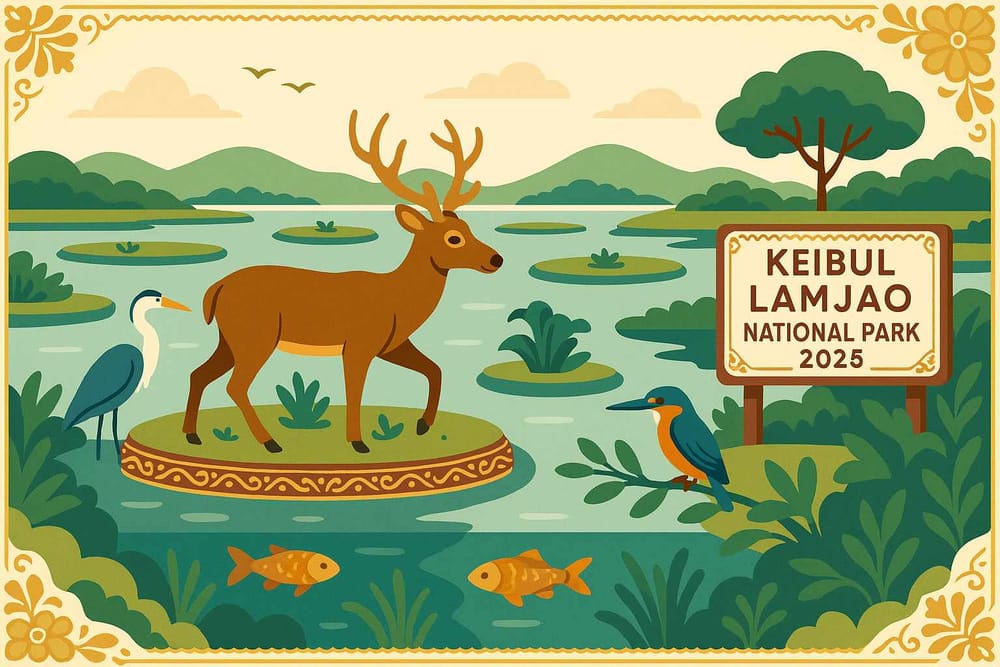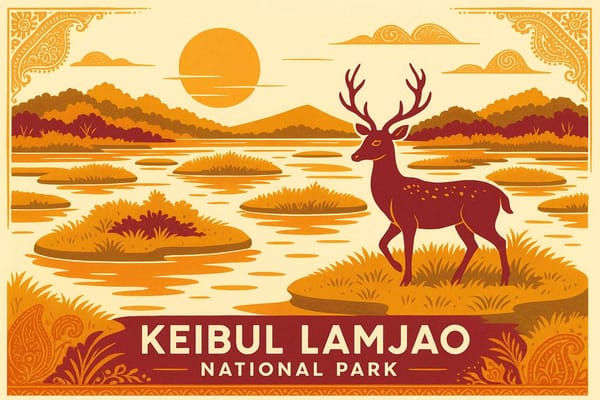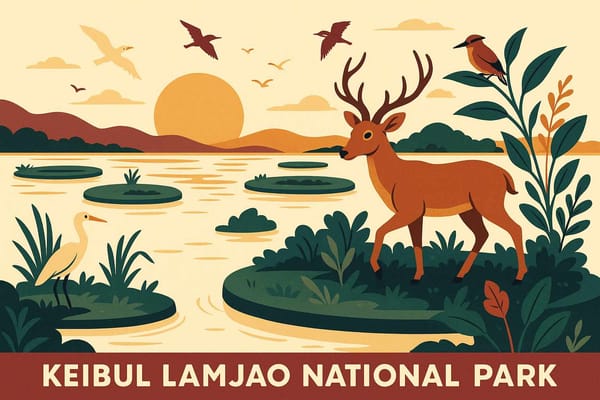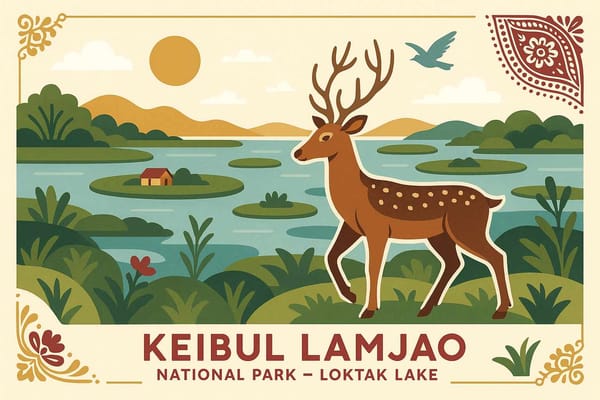
Keibul Lamjao National Park's Ecosystem: A 2025 Exploration
Imagine a place where the earth itself breathes and floats. A place where lush green islands, woven by nature's own hand, drift gently on the surface of a vast lake. This isn't a dream or a story from our ancient texts; this is the living miracle of Keibul Lamjao National Park in Manipur. Nestled in the heart of the magnificent Loktak Lake, this sanctuary is the only one of its kind in the entire world. It’s a place that touches your soul, reminding you of the delicate, divine artistry of creation.
For me, thinking about Keibul Lamjao feels like connecting with something primal and sacred. It's more than just a park; it's a testament to the beautiful harmony that can exist between humanity and nature, a relationship deeply cherished in our Indian culture.
The Heartbeat of the Park: The Miraculous Phumdis
The entire existence of Keibul Lamjao is built upon its most unique feature: the phumdis. These are not just clumps of vegetation; they are intricate, floating mats of soil, plants, and organic matter that have accumulated over centuries. They are thick enough to support not just grasses and reeds, but also the animals that call this park home. Watching them from a boat, you realise they are like living rafts, a floating paradise that sustains an entire web of life.
This delicate balance is constantly in motion. The water levels of Loktak Lake, changing with the seasons, dictate the life of these phumdis. This ever-shifting landscape is home to vibrant orchids, countless migratory birds whose songs fill the air, and fish that are found nowhere else on Earth. It’s a complete world, a floating tapestry of life.
The Pride of Manipur: The Gentle Sangai Deer
And on these floating islands, you will find the park's most precious resident – the Sangai deer. Known affectionately as the 'dancing deer' for its graceful, delicate gait as it balances on the shifting phumdis, the Sangai is the very soul of Manipur. Seeing this creature is not just a wildlife sighting; it’s an experience that connects you to the heritage of this land.
By 2025, there's good news to share. After years of being critically endangered, dedicated conservation efforts are finally bearing fruit. The Sangai population is seeing a hopeful rise. Authorities, working hand-in-hand with local communities, have focused on restoring the phumdis and curbing illegal activities. There are even plans being developed with the Wildlife Institute of India to reintroduce the Sangai to similar habitats nearby, securing its future for generations to come. For the people of Manipur, the Sangai is not just an animal; it is a symbol of their enduring spirit and deep connection to nature.
Shadows on the Water: The Challenges of Today
But this paradise is not without its struggles. As of 2025, Keibul Lamjao faces serious threats that test its resilience.
- Climate Change and Water Levels: Unpredictable rainfall patterns have started to affect the water levels of Loktak Lake. This disruption threatens the very stability of the phumdis, causing them to shrink and weaken, which in turn impacts the entire habitat that depends on them.
- Human Impact and Pollution: The health of the lake is being compromised by pollution from nearby areas and the effects of the Loktak Multipurpose Project, which has altered the natural cycle of the phumdis. Encroachment for fishing and agriculture puts additional pressure on this fragile sanctuary.
The Guardians of the Lake: A Community's Sacred Duty
The real strength of Keibul Lamjao lies in its people. The Meitei community, who have lived around Loktak Lake for generations, are not just residents; they are its true guardians. Their culture, livelihoods, and spirituality are deeply intertwined with the lake. They understand its rhythms better than anyone else.
It's heartening to see how this bond is translating into powerful conservation action. A new handloom cluster initiative launched in July 2025 near the park is a beautiful example. It empowers local women by training them in modern weaving and connects their craft to eco-tourism, creating a sustainable livelihood that also protects the environment. This community-led approach shows how preserving heritage and living traditions is the key to protecting our natural treasures. During the 71st Wildlife Week celebrations in October 2025, the government lauded these community-driven efforts, acknowledging that the future of this park lies in the hands of its people.
At Bhaktilipi, we are deeply moved by such stories of faith, culture, and preservation. We believe in sharing these timeless tales that connect us to our roots. Our platform is dedicated to bringing you devotional literature and stories that inspire, just like the story of Keibul Lamjao and its guardians.
Explore our collection on Bhaktilipi.in to find wisdom that resonates with today's world.
Your Questions Answered: Exploring Keibul Lamjao in 2025
What truly makes Keibul Lamjao so special?
Its uniqueness comes from being the world's only floating national park. The entire sanctuary rests on these incredible floating biomasses, or phumdis, which drift on Loktak Lake. This creates a one-of-a-kind habitat that you won't find anywhere else on the planet.
Where exactly is this natural wonder located?
You can find this gem in the Bishnupur district of Manipur, in Northeast India. It is an integral and protected part of the larger Loktak Lake, which is the biggest freshwater lake in the region.
Which animals are the stars of the park?
The park is most famous for being the last natural home of the endangered Sangai deer, the beloved 'dancing deer'. But it's also a sanctuary for other creatures like hog deer, otters, and a stunning variety of migratory and resident birds that make the park a birdwatcher's paradise.
What is the role of the phumdis in this floating world?
The phumdis are the foundation of this entire ecosystem. These floating islands of vegetation provide the land for animals to live and graze on. They are the breeding grounds for many species and are absolutely critical for the survival of the Sangai deer and the overall biodiversity of the park.
A Call to Cherish This Divine Creation
Keibul Lamjao National Park is more than just a destination; it's a living, breathing lesson in coexistence and natural wonder. It's a reminder of the sacred duty we have to protect these priceless gifts for the future. Let's cherish and support the efforts to preserve this floating paradise, ensuring that the Sangai deer continues to dance on these magical islands for centuries to come.
Stay connected with stories that touch the soul. Subscribe to our YouTube channel, and follow us on Facebook and Instagram for more inspiration and updates from the world of devotion, culture, and nature.
A passionate group of people dedicated to preserving India's knowledge of Dharma, Karma, and Bhakti for ourselves and the world 🙏.
Comments
Related in

Keibul Lamjao-The Only Floating National Park-A 2025 Guide
Imagine a place on Earth where the land itself breathes and sways upon the water. A place where deer don't just run, they seem to dance on floating meadows. This isn't a dream or a fairytale; this is the reality of Keibul Lamjao National Park in

Keibul Lamjao National Park Biodiversity: A Unique Exploration
Imagine a land that doesn't stay still, a forest that floats upon the water like a giant, sacred lotus leaf. This isn't a fable from our grandmothers' stories; this is the living, breathing miracle of Keibul Lamjao National Park in Manipur. It's a

Keibul Lamjao National Park-Wonders Await
Have you ever imagined a place where the very land you stand on is not solid ground, but a floating carpet of green, gently swaying on the water? It sounds like something from a dream or an ancient legend, but this place is very real. It’s a jewel nestled
